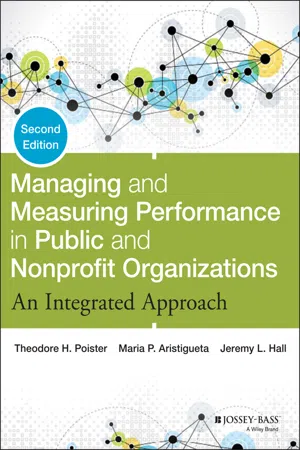
Managing and Measuring Performance in Public and Nonprofit Organizations
An Integrated Approach
- English
- ePUB (mobile friendly)
- Available on iOS & Android
Managing and Measuring Performance in Public and Nonprofit Organizations
An Integrated Approach
About this book
New edition of a classic guide to ensuring effective organizational performance
Thoroughly revised and updated, the second edition of Managing and Measuring Performance in Public and Nonprofit Organizations is a comprehensive resource for designing and implementing effective performance management and measurement systems in public and nonprofit organizations. The ideas, tools, and processes in this vital resource are designed to help organizations develop measurement systems to support such effective management approaches as strategic management, results-based budgeting, performance management, process improvement, performance contracting, and much more.
The book will help readers identify outcomes and other performance criteria to be measured, tie measures to goals and objectives, define and evaluate the worth of desired performance measures, and analyze, process, report, and utilize data effectively.
- Includes significant updates that offer a more integrated approach to performance management and measurement
- Offers a detailed framework and instructions for developing and implementing performance management systems
- Shows how to apply the most effective performance management principles
- Reveals how to overcome the barriers to effective performance management
Managing and Measuring Performance in Public and Nonprofit Organizations identifies common methodological and managerial problems that often confront managers in developing performance measurement systems, and presents a number of targeted strategies for the successful implementation of such systems in public and nonprofit organizations. This must-have resource will help leaders reach their organizational goals and objectives.
Frequently asked questions
- Essential is ideal for learners and professionals who enjoy exploring a wide range of subjects. Access the Essential Library with 800,000+ trusted titles and best-sellers across business, personal growth, and the humanities. Includes unlimited reading time and Standard Read Aloud voice.
- Complete: Perfect for advanced learners and researchers needing full, unrestricted access. Unlock 1.4M+ books across hundreds of subjects, including academic and specialized titles. The Complete Plan also includes advanced features like Premium Read Aloud and Research Assistant.
Please note we cannot support devices running on iOS 13 and Android 7 or earlier. Learn more about using the app.
Information
PART ONE
Introduction to Performance Measurement
CHAPTER ONE
Introduction to Performance Measurement and Management
- How does performance management fit within understood accountability frameworks?
- How extensively has performance management been implemented at various levels of government?
- What factors explain when and where performance management is adopted?
- Under what conditions is performance management effective?
- What is the relationship between capacity and performance, and what forms of organizational capacity are necessary to implement performance management effectively?
- What special conditions affect the use of performance management in networked or intergovernmental settings where authority is shared and goal ambiguity exists?
- Does performance management actually improve performance?
Public Management, Performance Management, and Accountability
Performance Measurement and Performance Management Defined
Table of contents
- Cover
- Table of Contents
- Title page
- Copyright page
- Dedication
- Preface
- Acknowledgments
- PART ONE: Introduction to Performance Measurement
- PART TWO: Methodological Elements of Performance Measurement
- PART THREE: Strategic Applications of Performance Management Principles
- PART FOUR: Design and Implementation of Performance Management Systems
- Name Index
- Subject Index
- End User License Agreement